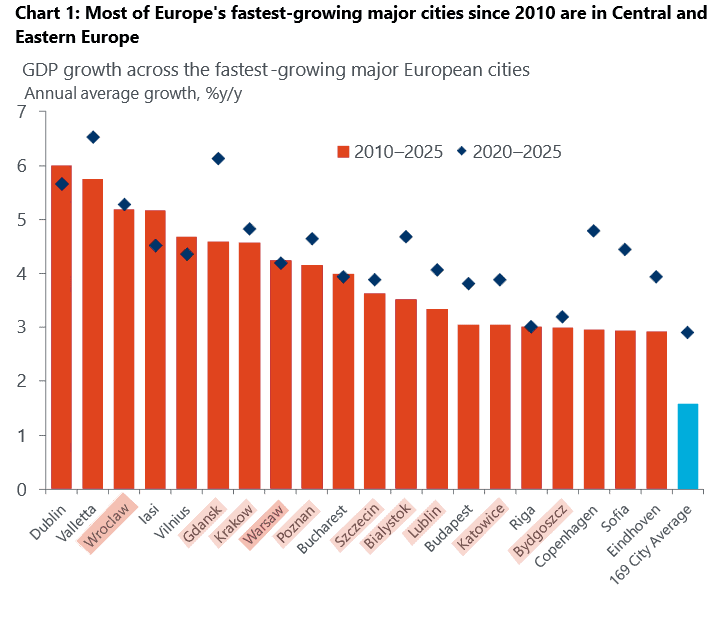Half of Europe's 20 fastest-growing cities are in Poland.
If you’re looking for the fastest-growing cities in Europe for property investment, forget London and Paris. The real action in the European real estate market is happening in Central and Eastern Europe, with Poland leading the charge. Over the past 15 years, ten Polish cities have ranked among Europe’s 20 fastest-growing economies, creating strong foundations for property market growth and attracting foreign investors.
Where to Invest in European Property: Fastest-Growing Cities Revealed

Why Economic Growth Matters for Property Investors
Economic growth drives property prices and gross annual rental yield. When a city’s economy expands, more jobs appear, wages rise, and people move in looking for opportunities. This creates demand for residential and commercial spaces, pushing up rental yields and capital values, which is critical in property investment analysis.
The data shows Dublin and Valletta topped the growth charts at 6.0% and 5.7% annually since 2010. But here’s what matters more: eight of the top ten fastest-growing cities are in Central and Eastern Europe, where property prices remain significantly lower than in Western Europe, offering good property investment opportunities.
The Polish Property Investment Opportunity
Half of Europe’s 20 fastest-growing cities are in Poland. That’s a remarkable concentration of opportunity in one country, with steady development in business sectors and a vibrant cultural scene.
Wroclaw led the pack with 5.2% annual growth, placing third overall in Europe. But it’s not just one city – this growth is spread across multiple Polish urban centres, reducing your risk if you’re building a property portfolio.
What’s driving this growth? Productivity improvements and rising tourism. Polish cities are catching up to Western European productivity levels through technology adoption and better business practices. This isn’t a temporary boom—it’s fundamental economic strengthening that supports long-term property value growth and attracts real estate investors seeking high rental yield ratings.
Average property prices in Polish cities remain attractive compared to Western Europe, making it easier for foreign investors to acquire property. Additionally, Poland offers relatively low property buying costs and a favourable tax regime for foreign investors, contributing to its appeal as a high-yield market.
Where the Smart Money Is Going Right Now
Spanish Cities: The Post-COVID Winners
Since 2020, Spanish cities have stolen the spotlight. Mallorca, Malaga, and Tenerife are each growing at over 6% annually—three times faster than before Covid.
What’s changed:
- Tourism has rebounded strongly, fueled by the country’s wine industry and cultural heritage
- The technology and finance sectors are expanding
- Remote working trends are attracting skilled workers
- Liberal immigration policies are boosting population growth
For buy-to-let investors, Spanish cities offer strong rental demand from both tourists and long-term residents. The combination of lifestyle appeal and economic growth creates multiple income streams, with attractive property buying costs and competitive property taxes.
Spain’s property prices jumped in recent years, yet rent prices remain high, ensuring very good yield ratings for investors. The country also offers a variety of property types, including residential properties and commercial properties, catering to diverse investment purposes.
Greek Cities: The Comeback Story
Athens and Thessaloniki have flipped from contraction to healthy growth. After a brutal decade following the financial crisis, Greece’s two largest cities are now expanding. This represents a classic recovery opportunity where property prices haven’t yet caught up with economic fundamentals, offering excellent potential for real estate investment.
Government incentives encourage foreign investment, and the relatively low property buying costs, combined with rising rent prices, make Greek cities attractive for acquiring property. Greece is also an EU candidate country offering residence permits linked to property investment, appealing to non-EU citizens.
Central European Tech Hubs
Look beyond the capital cities. Smaller urban centres are delivering impressive returns:
Eindhoven (Netherlands) – Home to high-tech manufacturing, including ASML’s semiconductor equipment production
Aarhus (Denmark) – Denmark’s second city, hosting global finance and IT firms
Toulouse (France) – Strong ICT, aerospace and aeronautical industries
These cities combine employment growth with productivity gains, creating stable, long-term property market conditions that appeal to real estate investors.
The Service Sector Shift: What It Means for Investors
Here’s a critical insight: service sectors are driving growth across Europe’s top performers. Business services and ICT are the primary contributors to growth in 15 of the 20 fastest-growing cities.
Why this matters for property:
Service sector jobs typically pay well and attract educated workers who can afford higher rents. Unlike manufacturing, services aren’t tied to specific factory locations, making these economies more resilient. This shift impacts property management costs and local market conditions positively for investors.
Poland is emerging as a key European logistics hub, particularly important for warehouse and industrial property investors. The transport and logistics market across Central and Eastern Europe continues to expand, increasing demand for commercial real estate.
Two Different Growth Models, Two Investment Strategies
European cities are growing through two different mechanisms:
Productivity-led growth (Dublin, Iasi, Vilnius, Gdansk)
- Businesses produce more output per worker
- Represents catch-up growth in Eastern Europe
- Creates stable, fundamental economic strengthening
- Best for long-term capital appreciation and property purchase strategies
Employment-led growth (London, Amsterdam, Luxembourg, Cambridge, Bordeaux, Nantes)
- More people are moving in for work
- Driven by high living standards and job opportunities
- Creates immediate rental demand and high rental prices
- Best for rental yield strategies
Understanding which model applies to your target city helps you choose the right investment approach and optimise your property investment pay.
Cities to Watch Carefully
Not everything is positive. German automotive cities are struggling. Wolfsburg, Braunschweig, and Leipzig—all exposed to Volkswagen, BMW, and Porsche—have underperformed as the German car industry faces challenges.
This highlights why sector diversification matters. Cities dependent on one industry carry a higher risk in terms of property investment.
Where Should You Invest?
For capital growth: Focus on Central and Eastern European cities, particularly in Poland. Lower entry prices, strong productivity growth, and catch-up potential offer the best long-term appreciation prospects in the European property market.
For rental income, Spanish cities combine tourism demand with long-term residential needs. Greece offers recovery potential at reasonable prices, with government incentives for foreign investment.
For balanced portfolios: Mix locations across different growth models. Combine productivity-led cities (for appreciation) with employment-led cities (for yield).
For lower risk: Choose cities with diverse economies. Look for multiple growing sectors rather than reliance on one industry.
The Bottom Line
Western European property markets are mature and expensive. The real opportunities lie where economic growth is strongest—and that’s in Central and Eastern Europe, particularly Poland, plus recovering markets like Greece and booming Spanish cities.
Economic fundamentals drive property values. Cities with 5-6% annual growth rates will deliver stronger property returns than those growing at 1-2%. The gap in property prices between fast-growing Eastern cities and slower Western markets creates a clear opportunity for investors willing to look beyond traditional locations.
The European property map is being redrawn. The question isn’t whether to invest in these high-growth cities—it’s how much of your portfolio should be there. Always consider property tax rates, income tax, property buying costs, and local laws before making your property purchase to ensure compliance and maximise your annual net income.
Remember, this information does not constitute financial advice. Always do your own research and consult with a legal entity or real estate agency experienced in foreign investment to assess risks and opportunities in your chosen European countries.



